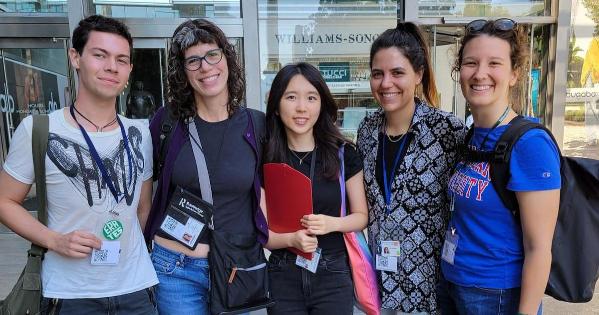Taking the Temperature of Global Warming

Milling about the streets of New York City during the March to End Fossil Fuels on September 17, SIS professor Dana Fisher and a small team of collaborators including Maxwell Downing, SIS/ BA ’23, and Caitlin Wiley, SIS/ MA ’24, saw an experiential learning opportunity amid an unconventional academic environment.
With QR codes on lanyards around their necks, the group of five canvassers from AU and Columbia University surveyed a few of the 75,000 participants to tease out the current climate on climate change.
Collecting a representative sample of 170 Qualtrics surveys from attendees, the researchers compiled valuable data about today’s climate advocates, including their political ideology, civic engagement, and motivation to participate in the event.
“It was an opportunity I couldn’t miss,” said Fisher, director of AU’s Center for Environment, Community, and Equity.
Among the team’s findings: 16 percent of marchers—who averaged 38 years of age—were participating in their first-ever protest. “This brought a lot of people who were new to the issue,” Fisher said.
Fisher’s team also asked participants about their personal experiences with extreme weather and their emotional response to climate change. Eighty-seven percent had experienced extreme heat in the previous six months. Another 75 percent said they felt strong or very strong anger about climate change and its effects—the most frequent emotion after sadness (81 percent).
“There’s some research that talks about how anger is a motivator, and people are starting to get angry about the climate crisis,” Fisher said. “But nobody had ever looked at that in a crowd before, so that’s really notable.”
This wasn’t the first time that Fisher—whose research interests include democracy, civic engagement, activism, and climate politics—surveyed people at a large-scale protest. She polled participants at the 2014 People’s Climate March in New York and the Women’s March on Washington in 2017, along with the protests after the murder of George Floyd.
Fisher doesn’t have plans to participate in another protest anytime soon, as the data from this month’s march—which will be compared against a national sample of the general population—will keep her plenty busy.
“But,” she said, “if the people rise up and start marching in the streets again, I probably will be back out there.”
